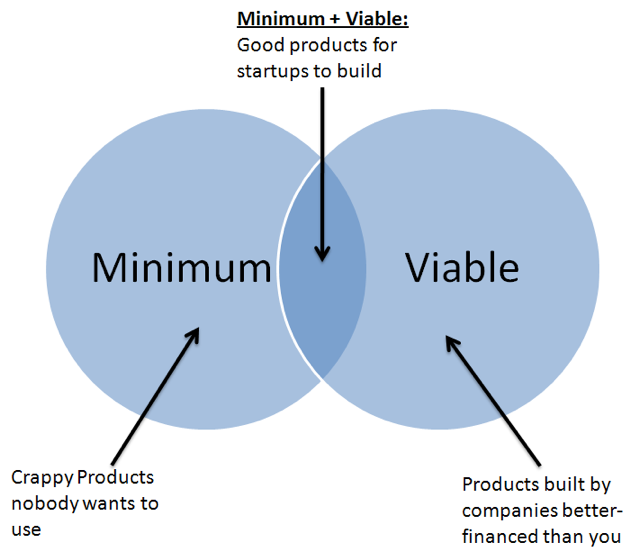The Lean Marketer: What You Need to Know About Minimum Viable Email
-
UncategorizedUpdatedPosted:
On this page
Most startup entrepreneurs are already familiar with Eric Ries’ lean startup methodology. The approach centers on the idea of a minimum viable product.
As Ries explains, a minimum viable product (MVP) “is that version of a new product which allows a team to collect the maximum amount of validated learning about customers with the least effort.”

Image via Paul Kortman
The product must be both minimal — requiring the least effort to create — and viable — functional enough that users can provide useful feedback. Rather than spending time and money perfecting a product, the lean approach gives entrepreneurs the chance to get rapid feedback, fail fast and improve quickly. It’s a data-based approach to product development and one that Ries has popularized on his blog and his book, The Lean Startup.
Minimum Viable [Fill in the Blank]
The minimum viable mindset can apply to many things outside of product development. In the content marketing world, Copyblogger’s Brian Clark has often discussed minimum viable audience and agile content marketing.
The idea is the same, just applied differently. He uses feedback from readers to shape future content, test ideas for new products and find new ways to solve the readers’ problems.
(It’s important to mention that at the core of the lean methodology is the need to solve problems, not push products. The product must evolve to suit the needs of the users. The same is true of a blog.)
In a post on the topic, Clark outlines the principles of a minimum viable audience:
You have an MVA when:
- You’re receiving enough feedback from comments, emails, social networks, and social media news sites in order to adapt and evolve your content to better serve the audience.
- You’re growing your audience organically thanks to social media sharing by existing audience members and earned media.
- You’re gaining enough insight into what the audience needs to solve their problems or satisfy their desires beyond the free education you’re providing.
Ries and Clark had a conversion about the topic on the Entreproducer podcast. It’s definitely worth 30 minutes of your time.
Now that we have a strong understand of the lean approach, let’s take a look at how we can apply the principle to email marketing.
Minimum Viable Email Marketing
In our post on why email marketing fails, I wrote that marketers often give up too soon. Just like a new startup or blog, successful email marketing doesn’t just happen overnight.
The lean model simply doesn’t work if you don’t iterate again and again, based on user feedback. Ries addresses this issue on his blog:
As long as you’re not afraid of the false negative, that is, if you don’t get discouraged because you’ve built your first paper prototype of it and shown it to people and nobody wanted it. That can’t mean that like you give up because,”Oh, forget it, we’ll never make it.” You’ve got to say, “OK, well then let’s iterate some more.”
So where should email marketers get started with the lean approach? Here are a few suggestions.
5 Tips for the Lean Email Marketer
- Collect email addresses from day one. I cannot emphasize day one enough. If you have any presence at all on the web, you need to be collecting email addresses, even if you have no idea what to do with. Don’t ever let a reader come to your website without the option to subscribe to a newsletter, get company updates or download an e-book. You are doing yourself and your business a disservice to ignore people who want to receive email from you.If your site or product hasn’t launched yet, collect email addresses with a “Coming Soon” page. Check out what ConversionXL’s Tommy Walker is doing with Social Filter to see what I mean.
- Email your readers from day one. This might seem crazy but an audience of one isn’t too small. If you are new to email marketing, you are going to make mistakes. Fail fast and evolve. You might as well make those mistakes before you have 10,000 people on your list. 🙂
- Iterate based on feedback. If you don’t actually listen and react to feedback, then you’re doing it all wrong. You might not like what you hear, but remember that your product or service is meant for your users. If they don’t like it, you can say goodbye to your budding business. This doesn’t mean you should listen to everything — surely some folks will have bad advice — but look for patterns in the feedback you get and spend time interacting with your subscribers to learn more about them.
- Observe the data. There are so many ways to see how people respond to your email marketing. You can always measure open and click rates. If you get good results, do more of whatever caused them. If they are bad, do less. You also need to be looking at unsubscribe rates, measuring which topics resonate with readers and constantly A/B testing subject lines and body copy. The best email marketers in the world, Amazon included, are constantly looking at data to help them send better email.
- Don’t give up. Email marketing is hard, there is no doubt about it. You will get frustrated. Try to keep in mind how incredibly powerful email marketing can be. Commit for the long haul, constantly test new ideas and spend time educating yourself on emerging trends and best practices.
What lessons have you learned that have improved your email marketing? Let us know in the comments.
Image via Financial Times
Want to send more personalized mobile and email messages to your users?
Learn moreCustomer story

How Vero helps Dribbble take full advantage of their customer data to improve personalization

